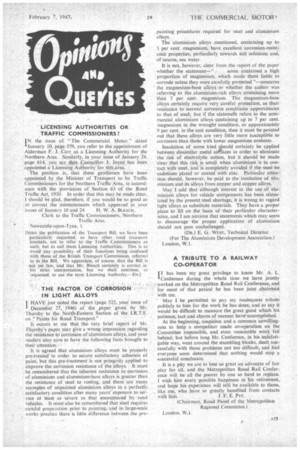THE FACTOR: OF 'CORROSION • IN LIGHT ALLOYS I HAVE
Page 47

If you've noticed an error in this article please click here to report it so we can fix it.
just noted the, report (page 525., your issue of A December 27, 1946) of the .paper given by Mr. Thursby to the North-Eastern Section of the I.R.T.E. on " Paints for Road Transport." It occurs to me that the very brief report Of Mr. ThUrsby's paper May give a wrong impression regarding the resistance to Corrosion of aluminium alloys, and your readers' May care to have the following facts brought to
their attention. • It is agreed that aluminium alloys must be properly pre-treated' in order to secure satisfactory adhesion of paint, blit this pre-treatment is not pritnarily applied to improve the corrosion resistance of the alloys. It must be remembered that the inherent resistance to corrosion of aluminium and aluminium-base alloys is greater than the resistance of steel to rusting, and there are many examples of unpainted aluminium alloys in a perfectly satisfactory condition after many years' exposure to service at least as severe as that encountered by road Vehicles. It must also be remembered that steel requires careful preparation prior to painting, and in large-scale works practice there is little difference between the pre- , painting procedures required for steel and aluminium alloys.
The aluminium alloys mentioned, containing up to 3 per cent magnesium have excellent corrosion resist anCe properties, particularly towards salt solutions and, of course, sea water.
It is not, however, clear from the report of the paper whether the statement—" . some contained a high proportion of magnesium, which made them liable to corrode unless they were carefully, protected "—concerns the magnesium-base alloys or whether the author was referring to the aluminium-rich alloys containing more than 3 per cent. magnesium. The magnesium-base alloys certainly require very careful protection, as their resistance to' normalcorrosive conditions approximates to that of steel; but if the statement refers to the commercial aluminium alloys containing up to 7 per cent. magnesium in the wrought condition, or approximately 9 per cent. in the cast condition, then it must be pointed . out that these alloys are very little more susceptible to corrosion than those with lower magnesium contents.
Insulation of some kind should certainly be applied between dissimilar metal surfaces in order to eliminate the risk of electrolytic action, but it should be made clear that this risk is small when aluminium is in Contact with steel, and is completely avoided if the steel be cadmium plated or coated with zinc. Particular attention should, however, be paid to the insulation of aluminium and its alloys from copper and copper alloys.
May I add that although interest in the use of aluminium alloys for vehicle components has been stimulated by the present steel shortage, it is wrong to regard light alloys as substitute materials. They have a proper place to fill on the basis cif their particular characteristics, and I am anxious that statements which may seem to discourage the proper application of aluminium should not pass unchallenged.
(Da.) E. G. WhsT, Technical Director. (For The Aluminium Development Association.) London, W.1.




















































































